Rama Shanker
Department of Statistics, Eritrea Institute of Technology, Asmara, Eritrea
Correspondence to: Rama Shanker, Department of Statistics, Eritrea Institute of Technology, Asmara, Eritrea.
| Email: |  |
Copyright © 2017 Scientific & Academic Publishing. All Rights Reserved.
This work is licensed under the Creative Commons Attribution International License (CC BY).
http://creativecommons.org/licenses/by/4.0/

Abstract
A Poisson-Akash distribution has been obtained by compounding Poisson distribution with Akash distribution introduced by Shanker (2015). A general expression for the th factorial moment has been derived and hence the first four moments about origin and the moments about mean has been obtained. The expressions for its coefficient of variation, skewness and kurtosis have been obtained. Its statistical properties including generating function, increasing hazard rate and unimodality and over-dispersion have been discussed. The maximum likelihood estimation and the method of moments for estimating its parameter have been discussed. The goodness of fit of the proposed distribution using maximum likelihood estimation has been given for some count data-sets and the fit is compared with that obtained by other distributions.
Keywords:
Akash distribution, Compounding, Moments, Skewness, Kurtosis, Estimation of parameter, Statistical properties, Goodness of fit
Cite this paper: Rama Shanker, The Discrete Poisson-Akash Distribution, International Journal of Probability and Statistics , Vol. 6 No. 1, 2017, pp. 1-10. doi: 10.5923/j.ijps.20170601.01.
1. Introduction
A lifetime distribution named, “Akash distribution” having probability density function  | (1.1) |
has been proposed by Shanker (2015) for modeling lifetime data from biomedical science and engineering and shown that the proposed distribution is a two-component mixture of exponential distribution having scale parameter  and a gamma distribution having shape parameter 3 and scale parameter
and a gamma distribution having shape parameter 3 and scale parameter  with their mixing proportions
with their mixing proportions  and
and  respectively. Various mathematical and statistical properties of Akash distribution including its shape, moments, skewness, kurtosis, hazard rate function, mean residual life function, stochastic ordering, mean deviations, distribution of order statistics, Bonferroni and Lorenz curves, Renyi entropy measure and stress-strength reliability have been discussed by Shanker (2015). It has been shown by Shanker (2015) that Akash distribution provides much closer fit than Lindley and exponential distributions for modeling lifetime data from medical science and engineering. Further, Shanker et al (2016) have done a detailed comparative study on Akash, Lindley and exponential distributions for modeling different types of lifetime data from engineering and medical science and concluded that Akash distribution has some advantage over Lindley and exponential distributions, Lindley distribution has some advantage over Akash and exponential distributions and exponential distribution has some advantage over Akash and Lindley distributions due to their over-dispersion, equi-dispersion, and under-dispersion for various values of their parameters. Recently, Shanker and Shukla (2016) has introduced a two-parameter weighted Akash distribution (WAD) andstudied its various mathematical and statistical properties, estimation of parameter and application for modeling lifetime data. Shanker (2016) has also proposed a two-parameter quasi Akash distribution and studied its statistical and mathematical properties, estimation of parameters using maximum likelihood estimation and method of moments along with its application for modeling lifetime data from engineering and biomedical sciences.In the present paper, a Poisson mixture of Akash distribution introduced by Shanker (2015) named, “Poisson-Akash distribution (PAD) has been proposed. Its various mathematical and statistical properties including its shape, moments, coefficient of variation, skewness, and kurtosis have been discussed. The estimation of its parameter has been discussed using maximum likelihood estimation and method of moments. The goodness of fit of PAD along with Poisson distribution and Poisson-Lindley distribution (PLD), a Poisson mixture of Lindley (1958) distribution and introduced by Sankaran (1970), has been given with some count data-sets.
respectively. Various mathematical and statistical properties of Akash distribution including its shape, moments, skewness, kurtosis, hazard rate function, mean residual life function, stochastic ordering, mean deviations, distribution of order statistics, Bonferroni and Lorenz curves, Renyi entropy measure and stress-strength reliability have been discussed by Shanker (2015). It has been shown by Shanker (2015) that Akash distribution provides much closer fit than Lindley and exponential distributions for modeling lifetime data from medical science and engineering. Further, Shanker et al (2016) have done a detailed comparative study on Akash, Lindley and exponential distributions for modeling different types of lifetime data from engineering and medical science and concluded that Akash distribution has some advantage over Lindley and exponential distributions, Lindley distribution has some advantage over Akash and exponential distributions and exponential distribution has some advantage over Akash and Lindley distributions due to their over-dispersion, equi-dispersion, and under-dispersion for various values of their parameters. Recently, Shanker and Shukla (2016) has introduced a two-parameter weighted Akash distribution (WAD) andstudied its various mathematical and statistical properties, estimation of parameter and application for modeling lifetime data. Shanker (2016) has also proposed a two-parameter quasi Akash distribution and studied its statistical and mathematical properties, estimation of parameters using maximum likelihood estimation and method of moments along with its application for modeling lifetime data from engineering and biomedical sciences.In the present paper, a Poisson mixture of Akash distribution introduced by Shanker (2015) named, “Poisson-Akash distribution (PAD) has been proposed. Its various mathematical and statistical properties including its shape, moments, coefficient of variation, skewness, and kurtosis have been discussed. The estimation of its parameter has been discussed using maximum likelihood estimation and method of moments. The goodness of fit of PAD along with Poisson distribution and Poisson-Lindley distribution (PLD), a Poisson mixture of Lindley (1958) distribution and introduced by Sankaran (1970), has been given with some count data-sets.
2. Poisson-Akash Distribution
Suppose the parameter  of Poisson distribution follows Akash distribution (1.1). Then the Poisson mixture of Akash distribution (1.1) can be obtained as
of Poisson distribution follows Akash distribution (1.1). Then the Poisson mixture of Akash distribution (1.1) can be obtained as 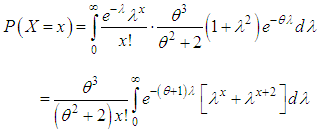 | (2.1) |
 | (2.2) |
We name this distribution “Poisson-Akash distribution (PAD)”. Shanker et al (2016) have detailed study on applications of PAD to model count data from different fields of knowledge.It would be recalled that Sankaran (1970) obtained Poisson-Lindley distribution (PLD) having probability mass function (p.m.f) | (2.3) |
by compounding Poisson distribution with Lindley distribution, introduced by Lindley (1958) having probability density function (p.d.f) | (2.4) |
Ghitany et al (2008) have discussed various interesting properties of Lindley distribution, estimation of parameter and application for modeling waiting time data from a bank. Shanker et al (2015) have detailed study on modeling of lifetime data using exponential and Lindley distributions. Further, Shanker et al (2016) have discussed the comparative applications of Akash, Lindley and exponential distributions for modeling lifetime data from biomedical sciences and engineering. Shanker and Hagos (2015) have detailed and critical study on applications of PLD to model count data from biological sciences.The graphs of the pmf of Poisson-Akash distribution (PAD) and Poisson-Lindley distribution (PLD) for different values of their parameter are shown in the figure 1. | Figure 1. Graphs of probability mass function of PAD and PLD for different values of the parameter θ |
3. Moments and Associated Measures
The rth factorial moment about origin of Poisson-Akash distribution (PAD) (2.2) can be obtained as 
 Using (2.1), the rth factorial moment about origin of PAD (2.2) can be obtained as
Using (2.1), the rth factorial moment about origin of PAD (2.2) can be obtained as Taking
Taking  in place of
in place of  within the bracket, we get
within the bracket, we get  The expression within the bracket is clearly unity and hence we have
The expression within the bracket is clearly unity and hence we have  Using gamma integral and a little algebraic simplification, we get finally, a general expression for the th factorial moment of PAD (2.2) as
Using gamma integral and a little algebraic simplification, we get finally, a general expression for the th factorial moment of PAD (2.2) as | (3.1) |
Substituting  in (3.1), the first four factorial moments about origin can be obtained and using the relationship between factorial moments about origin and moments about origin, the first four moment about origin of the PAD (2.2) are obtained as
in (3.1), the first four factorial moments about origin can be obtained and using the relationship between factorial moments about origin and moments about origin, the first four moment about origin of the PAD (2.2) are obtained as 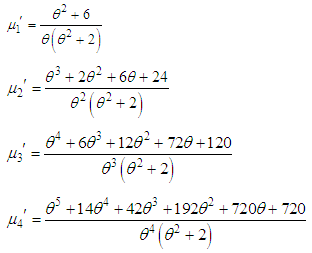 Using the relationship between moments about mean and the moments about origin, the moments about mean of the PAD (2.2) are obtained as
Using the relationship between moments about mean and the moments about origin, the moments about mean of the PAD (2.2) are obtained as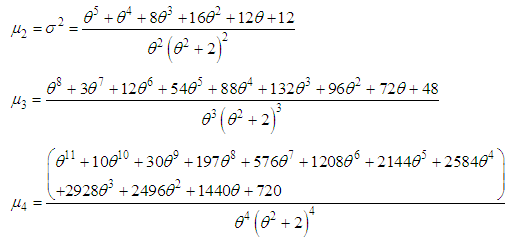 The coefficient of variation
The coefficient of variation , coefficient of skewness
, coefficient of skewness , coefficient of kurtosis
, coefficient of kurtosis , and index of dispersion
, and index of dispersion  of the PAD (2.2) are thus given by
of the PAD (2.2) are thus given by 
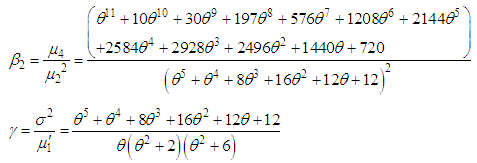 The expressions for
The expressions for  of PLD (2.3) obtained by Sankaran (1970) and Ghitany and Al-Mutairi (2009) are given by
of PLD (2.3) obtained by Sankaran (1970) and Ghitany and Al-Mutairi (2009) are given by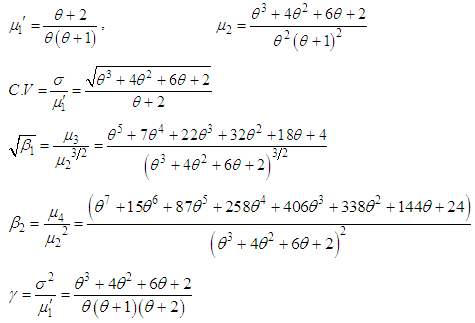
Table 1. Values of
 of PAD and PLD for different values of θ of PAD and PLD for different values of θ
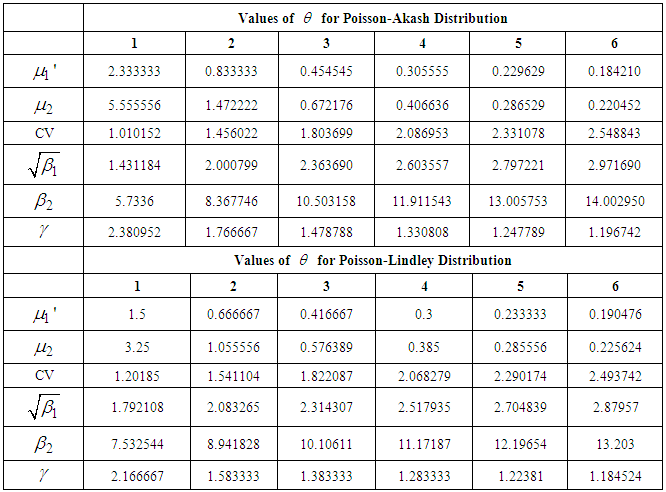 |
| |
|
To study the behavior of  of PAD and PLD, values of these characteristics for different values of parameter
of PAD and PLD, values of these characteristics for different values of parameter  have been computed and presented in table 1.The graphs of coefficient of variation, coefficient of skewness, coefficient of kurtosis and index of dispersion of PAD and PLD for different values of the parameter
have been computed and presented in table 1.The graphs of coefficient of variation, coefficient of skewness, coefficient of kurtosis and index of dispersion of PAD and PLD for different values of the parameter  have been shown in the figure 2.
have been shown in the figure 2.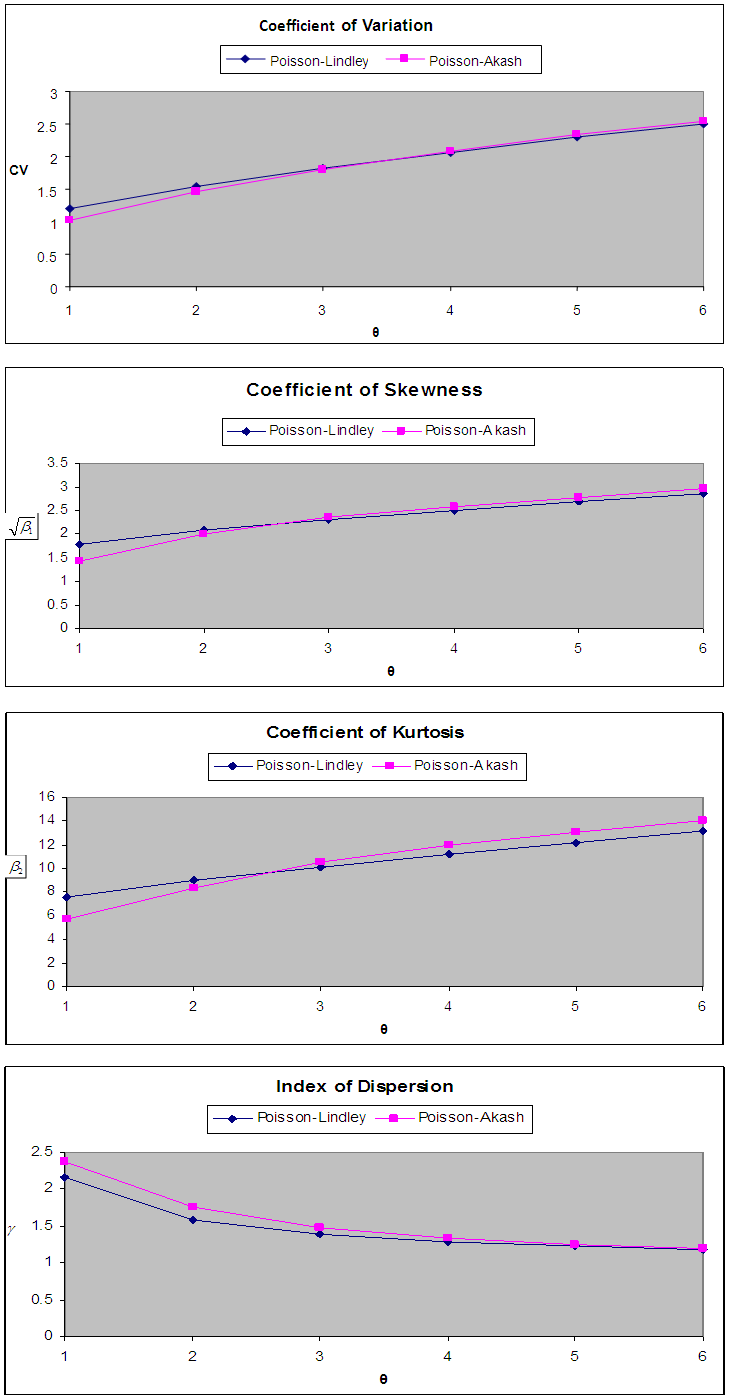 | Figure 2. Graphs of coefficient of variation, coefficient of skewness, coefficient of kurtosis and Index dispersion of PAD and PLD for different values of the parameter θ |
4. Mathematical and Statistical Properties
4.1. Increasing Hazard Rate and Unimodality
The PAD (2.2) has an increasing hazard rate (IHR) and unimodal. Since  is decreasing function in
is decreasing function in  is log-concave. Therefore, the PAD has an increasing hazard rate and unimodal. A detailed discussion about interrelationship between log-concavity, unimodality and increasing hazard rate (IHR) of discrete distributions can be seen in Grandell (1997).
is log-concave. Therefore, the PAD has an increasing hazard rate and unimodal. A detailed discussion about interrelationship between log-concavity, unimodality and increasing hazard rate (IHR) of discrete distributions can be seen in Grandell (1997).
4.2. Generating Functions
The probability generating function of PAD (2.2) can be obtained as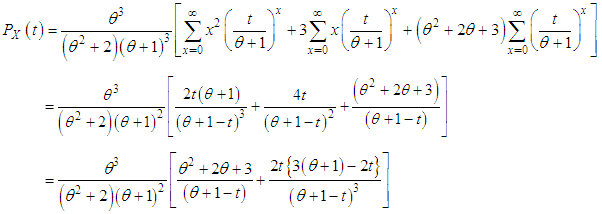 The moment generating function of the PAD (2.2) can thus be obtained as
The moment generating function of the PAD (2.2) can thus be obtained as
4.3. Over-dispersion
The PAD (2.2) is always over-dispersed  . We have
. We have This shows that PAD (2.2) is always over dispersed.
This shows that PAD (2.2) is always over dispersed.
5. Estimation of the Parameter
5.1. Maximum Likelihood Estimate (MLE)
Let  be a random sample of size
be a random sample of size  from the PAD (2.2) and let
from the PAD (2.2) and let  be the observed frequency in the sample corresponding to
be the observed frequency in the sample corresponding to  such that
such that  , where
, where  is the largest observed value having non-zero frequency. The likelihood function
is the largest observed value having non-zero frequency. The likelihood function  of the PAD (2.2) is given by
of the PAD (2.2) is given by The log likelihood function is thus obtained as
The log likelihood function is thus obtained as The first derivative of the log likelihood function is given by
The first derivative of the log likelihood function is given by  where
where  is the sample mean.The maximum likelihood estimate (MLE),
is the sample mean.The maximum likelihood estimate (MLE),  of
of  of PAD (2.2) is the solution of the equation
of PAD (2.2) is the solution of the equation  and is given by the solution of the following non-linear equation
and is given by the solution of the following non-linear equation This non-linear equation can be solved by any numerical iteration methods such as Newton- Raphson, Bisection method, Regula –Falsi method etc
This non-linear equation can be solved by any numerical iteration methods such as Newton- Raphson, Bisection method, Regula –Falsi method etc
5.2. Method of Moment Estimate (MOME)
Let  be a random sample of size
be a random sample of size  from the PAD (2.2). Equating the population mean to the corresponding sample mean, the MOME
from the PAD (2.2). Equating the population mean to the corresponding sample mean, the MOME  of
of  of PAD (2.2) is the solution of the following cubic equation
of PAD (2.2) is the solution of the following cubic equation where
where  is the sample mean.
is the sample mean.
6. Goodness of Fit
The PAD has been fitted to a number of data - sets to test its goodness of fit with Poisson distribution (PD) and Poisson-Lindley distribution (PLD. The maximum likelihood estimate (MLE) has been used to fit the PAD. Five examples of observed count data-sets, for which the PAD, PD, and PLD has been fitted, are presented. The first data-set is due to Kemp and kemp (1965) regarding the distribution of mistakes in copying groups of random digits, the second data-set is due to Beall (1940) regarding the distribution of Pyrausta nublilalis, the third data-set is the number of accidents to 647 women working on high explosive shells in 5 weeks, available in Sankaran (1970), the fourth data-set is the distribution of red mites per leaf on apple leaves, available in Fisher et al (1943), and the fifth data-set is distribution of number of Chromatid aberrations, available in Loeschke and Kohler (1976) and Janardan and Schaeffer (1977). Table 6.1. Distribution of mistakes in copying groups of random digits
 |
| |
|
Table 6.2. Distribution of Pyrausta nublilalis
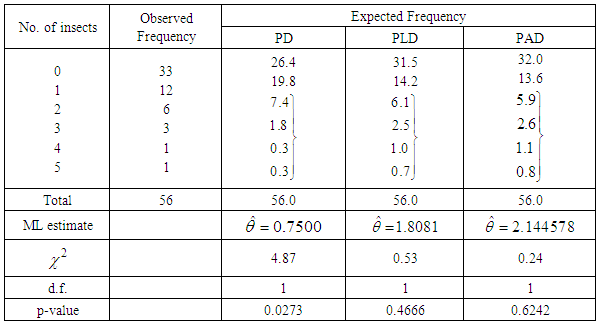 |
| |
|
Table 6.3. Accidents to 647 women working on high explosive shells
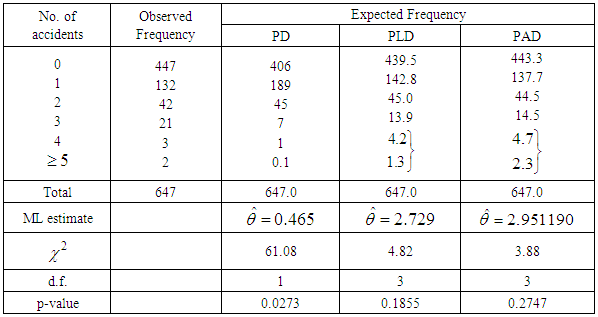 |
| |
|
Table 6.4. Distribution of number of red mites on Apple leaves, Fisher et al (1943)
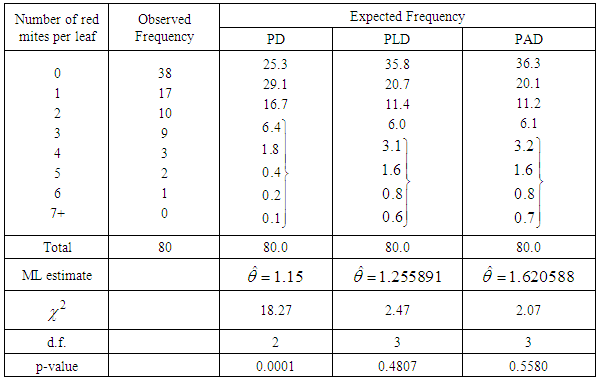 |
| |
|
Table 6.5. Distribution of number of Chromatid aberrations (0.2 g chinon 1, 24 hours)
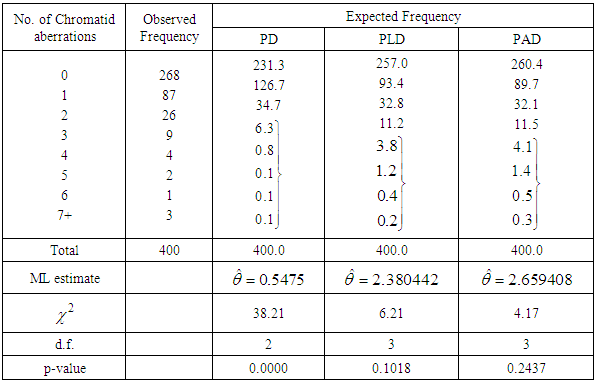 |
| |
|
7. Concluding Remarks
In this paper Poisson-Akash distribution (PAD) has been obtained by compounding Poisson distribution with Akash distribution introduced by Shanker (2015). The expression for the rth factorial moment has been derived and hence the first four moments about origin and the moments about mean has been given. The expression for coefficient of variation, skewness and kurtosis has been obtained. The maximum likelihood estimation and the method of moments for estimating its parameter have been discussed. The distribution has been fitted using maximum likelihood estimate to some data - sets to test its goodness of fit over Poisson distribution (PD) and Poisson-Lindley distribution (PLD) and it is clear from the fit of PAD that PAD gives much closer fit than PD and PLD in almost all data-sets.
ACKNOWLEDGEMENTS
The author is grateful to the editor-in-chief of the journal and the reviewer for constructive comments which lead to the improvement in the quality of the paper.
References
| [1] | Beall, G. (1940): The fit and significance of contagious distributions when applied to observations on larval insects, Ecology, 21, 460-474. |
| [2] | Fisher, R.A., Corpet, A.S. and Williams, C.B. (1943): The relation between the number of species and the number of individuals in a random sample of an animal population, Journal of Animal ecology, 12, 42 – 58. |
| [3] | Ghitany, M.E., Atieh, B. and Nadarajah, S (2008): Lindley distribution and its Application, Mathematics Computing and Simulation, 78, 493 – 506. |
| [4] | Ghitany, M.E. and Al-Mutairi, D.K. (2009): Estimation method for the discrete Poisson-Lindley distribution, Journal of Statistical Computation and Simulation, 79 (1), 1 – 9. |
| [5] | Grandell, J. (1997): Mixed Poisson Processes, Chapman& Hall, London. |
| [6] | Janardan, K.G. and Schaeffer, D.J. (1977): Models for the analysis of chromosomal aberrations in human leukocytes, Biometrical Journal, 19(8), 599 – 612. |
| [7] | Kemp, C.D. and Kemp, A.W. (1965): Some properties of the Hermite distribution, Biometrika, 52, 381-394. |
| [8] | Lindley, D.V. (1958): Fiducial distributions and Bayes theorem, Journal of the Royal Statistical Society, 20 (1), 102- 107. |
| [9] | Loeschke, V. and Kohler, W. (1976): Deterministic and Stochastic models of the negative binomial distribution and the analysis of chromosomal aberrations in human leukocytes, Biometrische Zeitschrift, 18, 427 -451. |
| [10] | Sankaran, M. (1970): The discrete Poisson-Lindley distribution, Biometrics, 26, 145- 149. |
| [11] | Shanker, R. (2015): Akash distribution and Its Applications, International Journal of Probability and Statistics, 4(3), 65 -75. |
| [12] | Shanker, R., Hagos, F. and Sujatha, S. (2016): On modeling of lifetimes data using one parameter Akash, Lindley and exponential distributions, Biometrics & Biostatistics International Journal, 3(2), 1 – 10. |
| [13] | Shanker, R. Hagos, F. and Teklay, T. (2016): On Poisson-Akash distribution and Its Applications, Biometrics & Biostatistics International Journal, 3(6), 1 – 9. |
| [14] | Shanker, R., Hagos, F. and Sujatha, S. (2015): On Modeling of Lifetimes data using Exponential and Lindley distributions: Biometrics & Biostatistics International Journal, 2(5), 1-9. |
| [15] | Shanker, R. and Hagos, F. (2015): On Poisson-Lindley distribution and its Applications to Biological Sciences, Biometrics & Biostatistics International Journal, 2(4), 1-5. |
| [16] | Shanker, R. and Shukla, K.K. (2016): Weighted Akash distribution and Its Application to model lifetime data, International Journal of Statistics, 39 (2), 1138 – 1147. |
| [17] | Shanker, R. (2016): A Quasi Akash Distribution To appear in Assam Statistical Review. |




 and a gamma distribution having shape parameter 3 and scale parameter
and a gamma distribution having shape parameter 3 and scale parameter  with their mixing proportions
with their mixing proportions  and
and  respectively. Various mathematical and statistical properties of Akash distribution including its shape, moments, skewness, kurtosis, hazard rate function, mean residual life function, stochastic ordering, mean deviations, distribution of order statistics, Bonferroni and Lorenz curves, Renyi entropy measure and stress-strength reliability have been discussed by Shanker (2015). It has been shown by Shanker (2015) that Akash distribution provides much closer fit than Lindley and exponential distributions for modeling lifetime data from medical science and engineering. Further, Shanker et al (2016) have done a detailed comparative study on Akash, Lindley and exponential distributions for modeling different types of lifetime data from engineering and medical science and concluded that Akash distribution has some advantage over Lindley and exponential distributions, Lindley distribution has some advantage over Akash and exponential distributions and exponential distribution has some advantage over Akash and Lindley distributions due to their over-dispersion, equi-dispersion, and under-dispersion for various values of their parameters. Recently, Shanker and Shukla (2016) has introduced a two-parameter weighted Akash distribution (WAD) andstudied its various mathematical and statistical properties, estimation of parameter and application for modeling lifetime data. Shanker (2016) has also proposed a two-parameter quasi Akash distribution and studied its statistical and mathematical properties, estimation of parameters using maximum likelihood estimation and method of moments along with its application for modeling lifetime data from engineering and biomedical sciences.In the present paper, a Poisson mixture of Akash distribution introduced by Shanker (2015) named, “Poisson-Akash distribution (PAD) has been proposed. Its various mathematical and statistical properties including its shape, moments, coefficient of variation, skewness, and kurtosis have been discussed. The estimation of its parameter has been discussed using maximum likelihood estimation and method of moments. The goodness of fit of PAD along with Poisson distribution and Poisson-Lindley distribution (PLD), a Poisson mixture of Lindley (1958) distribution and introduced by Sankaran (1970), has been given with some count data-sets.
respectively. Various mathematical and statistical properties of Akash distribution including its shape, moments, skewness, kurtosis, hazard rate function, mean residual life function, stochastic ordering, mean deviations, distribution of order statistics, Bonferroni and Lorenz curves, Renyi entropy measure and stress-strength reliability have been discussed by Shanker (2015). It has been shown by Shanker (2015) that Akash distribution provides much closer fit than Lindley and exponential distributions for modeling lifetime data from medical science and engineering. Further, Shanker et al (2016) have done a detailed comparative study on Akash, Lindley and exponential distributions for modeling different types of lifetime data from engineering and medical science and concluded that Akash distribution has some advantage over Lindley and exponential distributions, Lindley distribution has some advantage over Akash and exponential distributions and exponential distribution has some advantage over Akash and Lindley distributions due to their over-dispersion, equi-dispersion, and under-dispersion for various values of their parameters. Recently, Shanker and Shukla (2016) has introduced a two-parameter weighted Akash distribution (WAD) andstudied its various mathematical and statistical properties, estimation of parameter and application for modeling lifetime data. Shanker (2016) has also proposed a two-parameter quasi Akash distribution and studied its statistical and mathematical properties, estimation of parameters using maximum likelihood estimation and method of moments along with its application for modeling lifetime data from engineering and biomedical sciences.In the present paper, a Poisson mixture of Akash distribution introduced by Shanker (2015) named, “Poisson-Akash distribution (PAD) has been proposed. Its various mathematical and statistical properties including its shape, moments, coefficient of variation, skewness, and kurtosis have been discussed. The estimation of its parameter has been discussed using maximum likelihood estimation and method of moments. The goodness of fit of PAD along with Poisson distribution and Poisson-Lindley distribution (PLD), a Poisson mixture of Lindley (1958) distribution and introduced by Sankaran (1970), has been given with some count data-sets. of Poisson distribution follows Akash distribution (1.1). Then the Poisson mixture of Akash distribution (1.1) can be obtained as
of Poisson distribution follows Akash distribution (1.1). Then the Poisson mixture of Akash distribution (1.1) can be obtained as 





 Using (2.1), the rth factorial moment about origin of PAD (2.2) can be obtained as
Using (2.1), the rth factorial moment about origin of PAD (2.2) can be obtained as Taking
Taking  in place of
in place of  within the bracket, we get
within the bracket, we get  The expression within the bracket is clearly unity and hence we have
The expression within the bracket is clearly unity and hence we have  Using gamma integral and a little algebraic simplification, we get finally, a general expression for the th factorial moment of PAD (2.2) as
Using gamma integral and a little algebraic simplification, we get finally, a general expression for the th factorial moment of PAD (2.2) as
 in (3.1), the first four factorial moments about origin can be obtained and using the relationship between factorial moments about origin and moments about origin, the first four moment about origin of the PAD (2.2) are obtained as
in (3.1), the first four factorial moments about origin can be obtained and using the relationship between factorial moments about origin and moments about origin, the first four moment about origin of the PAD (2.2) are obtained as  Using the relationship between moments about mean and the moments about origin, the moments about mean of the PAD (2.2) are obtained as
Using the relationship between moments about mean and the moments about origin, the moments about mean of the PAD (2.2) are obtained as The coefficient of variation
The coefficient of variation , coefficient of skewness
, coefficient of skewness , coefficient of kurtosis
, coefficient of kurtosis , and index of dispersion
, and index of dispersion  of the PAD (2.2) are thus given by
of the PAD (2.2) are thus given by 
 The expressions for
The expressions for  of PLD (2.3) obtained by Sankaran (1970) and Ghitany and Al-Mutairi (2009) are given by
of PLD (2.3) obtained by Sankaran (1970) and Ghitany and Al-Mutairi (2009) are given by
 of PAD and PLD, values of these characteristics for different values of parameter
of PAD and PLD, values of these characteristics for different values of parameter  have been computed and presented in table 1.The graphs of coefficient of variation, coefficient of skewness, coefficient of kurtosis and index of dispersion of PAD and PLD for different values of the parameter
have been computed and presented in table 1.The graphs of coefficient of variation, coefficient of skewness, coefficient of kurtosis and index of dispersion of PAD and PLD for different values of the parameter  have been shown in the figure 2.
have been shown in the figure 2.
 is decreasing function in
is decreasing function in  is log-concave. Therefore, the PAD has an increasing hazard rate and unimodal. A detailed discussion about interrelationship between log-concavity, unimodality and increasing hazard rate (IHR) of discrete distributions can be seen in Grandell (1997).
is log-concave. Therefore, the PAD has an increasing hazard rate and unimodal. A detailed discussion about interrelationship between log-concavity, unimodality and increasing hazard rate (IHR) of discrete distributions can be seen in Grandell (1997). The moment generating function of the PAD (2.2) can thus be obtained as
The moment generating function of the PAD (2.2) can thus be obtained as
 . We have
. We have This shows that PAD (2.2) is always over dispersed.
This shows that PAD (2.2) is always over dispersed. be a random sample of size
be a random sample of size  from the PAD (2.2) and let
from the PAD (2.2) and let  be the observed frequency in the sample corresponding to
be the observed frequency in the sample corresponding to  such that
such that  , where
, where  is the largest observed value having non-zero frequency. The likelihood function
is the largest observed value having non-zero frequency. The likelihood function  of the PAD (2.2) is given by
of the PAD (2.2) is given by The log likelihood function is thus obtained as
The log likelihood function is thus obtained as The first derivative of the log likelihood function is given by
The first derivative of the log likelihood function is given by  where
where  is the sample mean.The maximum likelihood estimate (MLE),
is the sample mean.The maximum likelihood estimate (MLE),  of
of  of PAD (2.2) is the solution of the equation
of PAD (2.2) is the solution of the equation  and is given by the solution of the following non-linear equation
and is given by the solution of the following non-linear equation This non-linear equation can be solved by any numerical iteration methods such as Newton- Raphson, Bisection method, Regula –Falsi method etc
This non-linear equation can be solved by any numerical iteration methods such as Newton- Raphson, Bisection method, Regula –Falsi method etc be a random sample of size
be a random sample of size  from the PAD (2.2). Equating the population mean to the corresponding sample mean, the MOME
from the PAD (2.2). Equating the population mean to the corresponding sample mean, the MOME  of
of  of PAD (2.2) is the solution of the following cubic equation
of PAD (2.2) is the solution of the following cubic equation where
where  is the sample mean.
is the sample mean. Abstract
Abstract Reference
Reference Full-Text PDF
Full-Text PDF Full-text HTML
Full-text HTML of PAD and PLD for different values of θ
of PAD and PLD for different values of θ 




